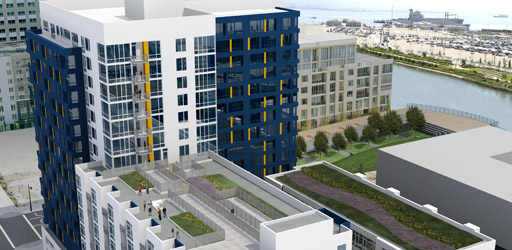The Pacific Coast Builders Conference, held in San Francisco last month, paid tribute to the green building craze sweeping town like proverbial wildfire, in part due to mandates passed in recent years stating all municipal buildings must build to green code, and also because San Francisco, as usual, leads the way in being kind to the planet on many fronts.

Photos courtesy of Arterra
By Michelle Slade
Published: July, 2007
A media roundtable hosted by Jeffrey Scott Advertising during the conference focused on the realities, good and bad, of building green and how that applies to commercial and residential building practices.
While the amount of applications for green commercial construction in the City is almost overwhelming, the uptake is slower for green residential building, explained conference presenter Doug Hill, project manager on the Mission Bay residential project, Arterra. Arterra is being built as the first LEED certified condominium/residential project in the city and is scheduled to open in May ’08.
As Hill sees it, until greater demand kicks in, green products applicable to the residential building market continue to be more expensive and are considered to be a riskier investment. However, green builders are thinking about the future and considering the cost and payback of their investment, too. It’s not just a matter of what costs more now, but what green building products will actually pay off in the long run — for the environment and the bottom line.
In a residential setting one of the big money savers is in energy, specifically high efficiency heating and cooling. Hill said, At Arterra there is no air conditioning, as this is San Francisco and if you need air conditioning you open up the windows.
Appliances use approximately 30 percent of energy usage in a typical household. Arterra residents will reduce this by using high efficiency appliances, called Energy Star Rated Appliances. Arterra has also installed dual flush toilets, a new concept in the United States, although these have been widely used in Europe and Japan for years, and even mandated in Australia.
Another green product that is being used for constructing green building exteriors, (Arterra included) is a material called TRESPA, a European product made from wood pulp and a recycled resin that is extremely weather resistant. TRESPA provides a building with what could be described as a breathable rain screen, so important in diverting the onset of damp and mold and keeping moisture away from interior walls. This material also repels dirt and is resistant to defacing attempts or impact damage.
Other features that promote green residential living include design that leverages natural lighting reducing the need to switch on electric lights. Outside, native landscaping reduces irrigation costs. And, green roofs help control storm water run-off, incorporate native plants, which promote native species like butterflies and birds, and reduce the heat island effect, which helps remediate the climate effect that large buildings have in urban areas.
Other benefits of a sustainable building include lower VOCs (volatile organic compounds), significantly improving indoor air quality, which is a major tenet of the LEED program.
Hill is particularly proud that at Arterra, 92 percent of construction waste is being diverted from landfills. And, at a time when there are more people returning to live in urban areas, high-density urban living residential areas, like Arterra, make commuting easier with better access to public transportation and less need for a car.
Nonetheless, the question remains: What will be the resale value on sustainable condos compared to those conventionally constructed? Hill shrugs his shoulders, I wish I knew. This is such a new and unique investment area. We’ll know in about five years.

